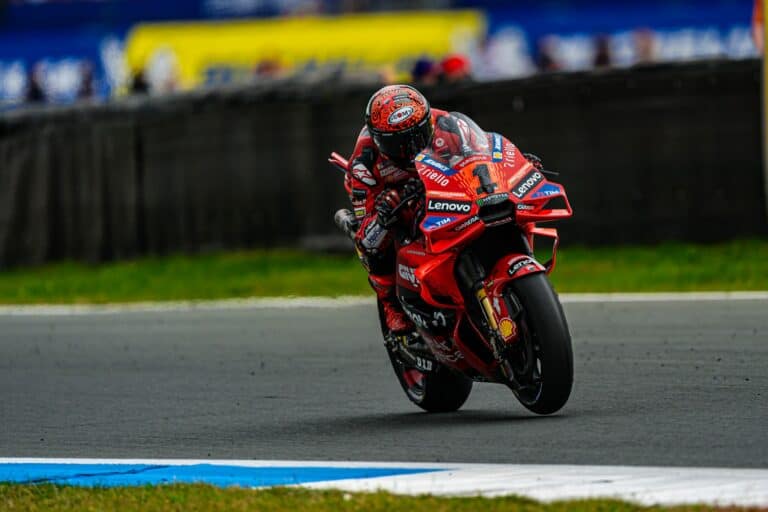When Ducati’s MotoGP team partnered with Lenovo in 2018, it opened up a world of IT possibilities. However, translating mountains of data into improved performance on the track is no small feat. How do both parties navigate this challenge?
MotoGP represents the pinnacle of motorcycle racing. While the speeds remain terrifying and the risks enormous like yesteryear, a new digital factor has emerged within the sport in recent years: IT. For the Ducati Lenovo Team, the partner in this technological revolution is, as the name suggests, Lenovo. We spoke with team members during the TT Assen to learn more about this multifaceted collaboration.
IT management with a stopwatch
Every MotoGP bike is not just a racing machine but also a high-speed data collector. Fifty sensors measure everything from tire pressure to throttle position, braking force, and lean angle. MotoGP rules strictly regulate data transmission, requiring an old-fashioned wired connection for data collection after each run. Every time a bike enters pit lane, the team stands ready to connect this digital umbilical cord to the vehicle.
Giacomo Gironi, Race IT Manager for the Ducati Lenovo Team, explains where this valuable information ends up. Lenovo’s ThinkAgile HCI appliance processes the data and applies internally developed algorithms to generate insights. NetApp on-board storage is put to work, while some 50 VMware virtual machines continuously perform calculations. The team analyzes everything from worrying vibrations to gaps between throttle and brake application, all contributing to potential performance improvements.
The edge servers used are Lenovo ThinkSystem SE350s, half as thick and considerably shorter than conventional 1U format servers. These travel with the team to every race weekend. Given the tight confines of the MotoGP paddock, this space-saving design is crucial. The servers must perform in any climate, from the sweltering heat of Indonesia to the drenching rains of Britain. Damage and even animal intrusions can occur during the rapid-paced transport between races.
Throughout the grueling racing calendar, which includes 20 or more races each year, the focus ultimately comes down to the rider and the tech expert. No matter how extensive the IT infrastructure, this final link remains the most critical. Riders Francesco Bagnaia and Enea Bastianini discuss new data insights every two or three runs. Sometimes the data aligns with the rider’s intuition, but often it doesn’t. According to Riccardo Savin, Vehicle Dynamics & Design Manager at Ducati Lenovo Team, there’s still much to be gained in this area. Integrating the rider into the IT processes remains a challenge, even as other aspects of the data puzzle fall into place.
Heavier artillery
The information gathered doesn’t just stay at the circuits of Assen, Misano, or Spielberg. Ducati Lenovo Team headquarters in Bologna constantly works with the data, especially during the off-season when the focus shifts entirely to the following year.
Aerodynamics has become an integral part of racing, including in MotoGP. Simulations based on Computational Fluid Dynamics (CFD) show Savin’s team where improvements can be made. The team has considerably more computing power at its Bologna headquarters than at the track. Here, they deploy Lenovo ThinkSystem SD530s, SD630s, and SR650s. For peak loads and the most demanding workloads, Microsoft Azure cloud resources are available through Lenovo as a Cloud Service Provider.
As of this season, a new piece of technology has been added to the team’s arsenal: a self-driving robot. This LiDAR-powered tool explores every circuit to create the most accurate digital twin possible. It generates 200GB of data per track, capturing 2.6 million data points per second with its onboard sensors. It’s essentially a miniature Google Earth, where the entire world is just the strip of asphalt between the guardrails, with every millimeter mapped with pinpoint accuracy.
However, MotoGP remains more dependent on real-world conditions than Formula 1. While F1 drivers can test-drive digital copies of circuits in simulators (including potential upgrades), it’s different for their two-wheeled counterparts. Correlation with the real world is far more challenging in MotoGP, increasing the importance of quick and accurate data insights during race weekends.
Intertwined
Since 2021, Lenovo has been the title sponsor of Ducati’s MotoGP team. While it’s not surprising to see the Lenovo logo prominently displayed on the riders’ bikes and suits, the collaboration extends far beyond advertising. Lenovo technology is integral to every aspect of the team’s operations. Daily tasks are carried out on Lenovo laptops and workstations, while Lenovo servers and cloud services power the team’s data analysis. The two companies jointly develop technology to accelerate insights and improve team communication. In essence, Lenovo and Ducati have become inseparable partners in racing.
Also read: TeamViewer CEO: “Remote access should be deployable everywhere”


